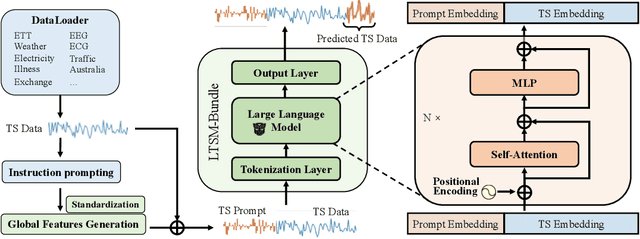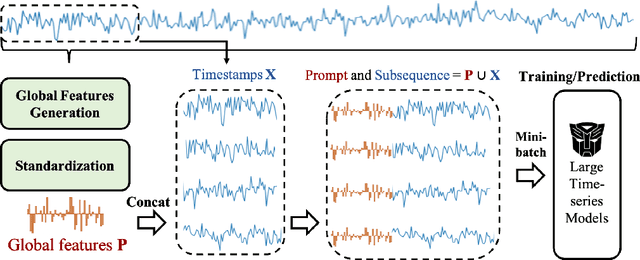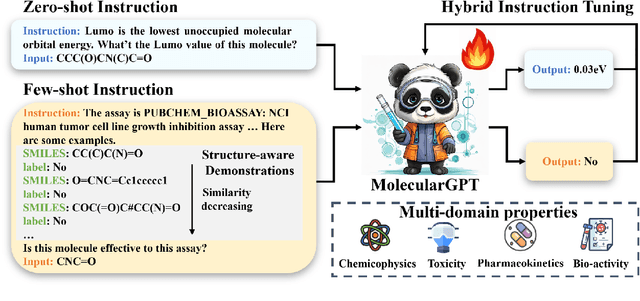Qiaoyu Tan
TrustGLM: Evaluating the Robustness of GraphLLMs Against Prompt, Text, and Structure Attacks
Jun 13, 2025Abstract:Inspired by the success of large language models (LLMs), there is a significant research shift from traditional graph learning methods to LLM-based graph frameworks, formally known as GraphLLMs. GraphLLMs leverage the reasoning power of LLMs by integrating three key components: the textual attributes of input nodes, the structural information of node neighborhoods, and task-specific prompts that guide decision-making. Despite their promise, the robustness of GraphLLMs against adversarial perturbations remains largely unexplored-a critical concern for deploying these models in high-stakes scenarios. To bridge the gap, we introduce TrustGLM, a comprehensive study evaluating the vulnerability of GraphLLMs to adversarial attacks across three dimensions: text, graph structure, and prompt manipulations. We implement state-of-the-art attack algorithms from each perspective to rigorously assess model resilience. Through extensive experiments on six benchmark datasets from diverse domains, our findings reveal that GraphLLMs are highly susceptible to text attacks that merely replace a few semantically similar words in a node's textual attribute. We also find that standard graph structure attack methods can significantly degrade model performance, while random shuffling of the candidate label set in prompt templates leads to substantial performance drops. Beyond characterizing these vulnerabilities, we investigate defense techniques tailored to each attack vector through data-augmented training and adversarial training, which show promising potential to enhance the robustness of GraphLLMs. We hope that our open-sourced library will facilitate rapid, equitable evaluation and inspire further innovative research in this field.
Graph-MLLM: Harnessing Multimodal Large Language Models for Multimodal Graph Learning
Jun 12, 2025Abstract:Multimodal Large Language Models (MLLMs) have demonstrated remarkable capabilities in representing and understanding diverse modalities. However, they typically focus on modality alignment in a pairwise manner while overlooking structural relationships across data points. Integrating multimodality with structured graph information (i.e., multimodal graphs, MMGs) is essential for real-world applications such as social networks, healthcare, and recommendation systems. Existing MMG learning methods fall into three paradigms based on how they leverage MLLMs: Encoder, Aligner, and Predictor. MLLM-as-Encoder focuses on enhancing graph neural networks (GNNs) via multimodal feature fusion; MLLM-as-Aligner aligns multimodal attributes in language or hidden space to enable LLM-based graph reasoning; MLLM-as-Predictor treats MLLMs as standalone reasoners with in-context learning or fine-tuning. Despite their advances, the MMG field lacks a unified benchmark to fairly evaluate across these approaches, making it unclear what progress has been made. To bridge this gap, we present Graph-MLLM, a comprehensive benchmark for multimodal graph learning by systematically evaluating these three paradigms across six datasets with different domains. Through extensive experiments, we observe that jointly considering the visual and textual attributes of the nodes benefits graph learning, even when using pre-trained text-to-image alignment models (e.g., CLIP) as encoders. We also find that converting visual attributes into textual descriptions further improves performance compared to directly using visual inputs. Moreover, we observe that fine-tuning MLLMs on specific MMGs can achieve state-of-the-art results in most scenarios, even without explicit graph structure information. We hope that our open-sourced library will facilitate rapid, equitable evaluation and inspire further innovative research in this field.
GRAPHGPT-O: Synergistic Multimodal Comprehension and Generation on Graphs
Feb 17, 2025



Abstract:The rapid development of Multimodal Large Language Models (MLLMs) has enabled the integration of multiple modalities, including texts and images, within the large language model (LLM) framework. However, texts and images are usually interconnected, forming a multimodal attributed graph (MMAG). It is underexplored how MLLMs can incorporate the relational information (\textit{i.e.}, graph structure) and semantic information (\textit{i.e.,} texts and images) on such graphs for multimodal comprehension and generation. In this paper, we propose GraphGPT-o, which supports omni-multimodal understanding and creation on MMAGs. We first comprehensively study linearization variants to transform semantic and structural information as input for MLLMs. Then, we propose a hierarchical aligner that enables deep graph encoding, bridging the gap between MMAGs and MLLMs. Finally, we explore the inference choices, adapting MLLM to interleaved text and image generation in graph scenarios. Extensive experiments on three datasets from different domains demonstrate the effectiveness of our proposed method. Datasets and codes will be open-sourced upon acceptance.
GraphICL: Unlocking Graph Learning Potential in LLMs through Structured Prompt Design
Jan 27, 2025



Abstract:The growing importance of textual and relational systems has driven interest in enhancing large language models (LLMs) for graph-structured data, particularly Text-Attributed Graphs (TAGs), where samples are represented by textual descriptions interconnected by edges. While research has largely focused on developing specialized graph LLMs through task-specific instruction tuning, a comprehensive benchmark for evaluating LLMs solely through prompt design remains surprisingly absent. Without such a carefully crafted evaluation benchmark, most if not all, tailored graph LLMs are compared against general LLMs using simplistic queries (e.g., zero-shot reasoning with LLaMA), which can potentially camouflage many advantages as well as unexpected predicaments of them. To achieve more general evaluations and unveil the true potential of LLMs for graph tasks, we introduce Graph In-context Learning (GraphICL) Benchmark, a comprehensive benchmark comprising novel prompt templates designed to capture graph structure and handle limited label knowledge. Our systematic evaluation shows that general-purpose LLMs equipped with our GraphICL outperform state-of-the-art specialized graph LLMs and graph neural network models in resource-constrained settings and out-of-domain tasks. These findings highlight the significant potential of prompt engineering to enhance LLM performance on graph learning tasks without training and offer a strong baseline for advancing research in graph LLMs.
Gradient Rewiring for Editable Graph Neural Network Training
Oct 21, 2024



Abstract:Deep neural networks are ubiquitously adopted in many applications, such as computer vision, natural language processing, and graph analytics. However, well-trained neural networks can make prediction errors after deployment as the world changes. \textit{Model editing} involves updating the base model to correct prediction errors with less accessible training data and computational resources. Despite recent advances in model editors in computer vision and natural language processing, editable training in graph neural networks (GNNs) is rarely explored. The challenge with editable GNN training lies in the inherent information aggregation across neighbors, which can lead model editors to affect the predictions of other nodes unintentionally. In this paper, we first observe the gradient of cross-entropy loss for the target node and training nodes with significant inconsistency, which indicates that directly fine-tuning the base model using the loss on the target node deteriorates the performance on training nodes. Motivated by the gradient inconsistency observation, we propose a simple yet effective \underline{G}radient \underline{R}ewiring method for \underline{E}ditable graph neural network training, named \textbf{GRE}. Specifically, we first store the anchor gradient of the loss on training nodes to preserve the locality. Subsequently, we rewire the gradient of the loss on the target node to preserve performance on the training node using anchor gradient. Experiments demonstrate the effectiveness of GRE on various model architectures and graph datasets in terms of multiple editing situations. The source code is available at \url{https://github.com/zhimengj0326/Gradient_rewiring_editing}
Reasoning Like a Doctor: Improving Medical Dialogue Systems via Diagnostic Reasoning Process Alignment
Jun 20, 2024



Abstract:Medical dialogue systems have attracted significant attention for their potential to act as medical assistants. Enabling these medical systems to emulate clinicians' diagnostic reasoning process has been the long-standing research focus. Previous studies rudimentarily realized the simulation of clinicians' diagnostic process by fine-tuning language models on high-quality dialogue datasets. Nonetheless, they overly focus on the outcomes of the clinician's reasoning process while ignoring their internal thought processes and alignment with clinician preferences. Our work aims to build a medical dialogue system that aligns with clinicians' diagnostic reasoning processes. We propose a novel framework, Emulation, designed to generate an appropriate response that relies on abductive and deductive diagnostic reasoning analyses and aligns with clinician preferences through thought process modeling. Experimental results on two datasets confirm the efficacy of Emulation. Crucially, our framework furnishes clear explanations for the generated responses, enhancing its transparency in medical consultations.
Understanding Different Design Choices in Training Large Time Series Models
Jun 20, 2024



Abstract:Inspired by Large Language Models (LLMs), Time Series Forecasting (TSF), a long-standing task in time series analysis, is undergoing a transition towards Large Time Series Models (LTSMs), aiming to train universal transformer-based models for TSF. However, training LTSMs on heterogeneous time series data poses unique challenges, including diverse frequencies, dimensions, and patterns across datasets. Recent endeavors have studied and evaluated various design choices aimed at enhancing LTSM training and generalization capabilities, spanning pre-processing techniques, model configurations, and dataset configurations. In this work, we comprehensively analyze these design choices and aim to identify the best practices for training LTSM. Moreover, we propose \emph{time series prompt}, a novel statistical prompting strategy tailored to time series data. Furthermore, based on the observations in our analysis, we introduce \texttt{LTSM-bundle}, which bundles the best design choices we have identified. Empirical results demonstrate that \texttt{LTSM-bundle} achieves superior zero-shot and few-shot performances compared to state-of-the-art LSTMs and traditional TSF methods on benchmark datasets.
MolecularGPT: Open Large Language Model (LLM) for Few-Shot Molecular Property Prediction
Jun 18, 2024



Abstract:Molecular property prediction (MPP) is a fundamental and crucial task in drug discovery. However, prior methods are limited by the requirement for a large number of labeled molecules and their restricted ability to generalize for unseen and new tasks, both of which are essential for real-world applications. To address these challenges, we present MolecularGPT for few-shot MPP. From a perspective on instruction tuning, we fine-tune large language models (LLMs) based on curated molecular instructions spanning over 1000 property prediction tasks. This enables building a versatile and specialized LLM that can be adapted to novel MPP tasks without any fine-tuning through zero- and few-shot in-context learning (ICL). MolecularGPT exhibits competitive in-context reasoning capabilities across 10 downstream evaluation datasets, setting new benchmarks for few-shot molecular prediction tasks. More importantly, with just two-shot examples, MolecularGPT can outperform standard supervised graph neural network methods on 4 out of 7 datasets. It also excels state-of-the-art LLM baselines by up to 16.6% increase on classification accuracy and decrease of 199.17 on regression metrics (e.g., RMSE) under zero-shot. This study demonstrates the potential of LLMs as effective few-shot molecular property predictors. The code is available at https://github.com/NYUSHCS/MolecularGPT.
UniGLM: Training One Unified Language Model for Text-Attributed Graphs
Jun 17, 2024



Abstract:Representation learning on text-attributed graphs (TAGs), where nodes are represented by textual descriptions, is crucial for textual and relational knowledge systems and recommendation systems. Currently, state-of-the-art embedding methods for TAGs primarily focus on fine-tuning language models (e.g., BERT) using structure-aware training signals. While effective, these methods are tailored for individual TAG and cannot generalize across various graph scenarios. Given the shared textual space, leveraging multiple TAGs for joint fine-tuning, aligning text and graph structure from different aspects, would be more beneficial. Motivated by this, we introduce a novel Unified Graph Language Model (UniGLM) framework, the first graph embedding model that generalizes well to both in-domain and cross-domain TAGs. Specifically, UniGLM is trained over multiple TAGs with different domains and scales using self-supervised contrastive learning. UniGLM includes an adaptive positive sample selection technique for identifying structurally similar nodes and a lazy contrastive module that is devised to accelerate training by minimizing repetitive encoding calculations. Extensive empirical results across 9 benchmark TAGs demonstrate UniGLM's efficacy against leading embedding baselines in terms of generalization (various downstream tasks and backbones) and transfer learning (in and out of domain scenarios). The code is available at https://github.com/NYUSHCS/UniGLM.
GAugLLM: Improving Graph Contrastive Learning for Text-Attributed Graphs with Large Language Models
Jun 17, 2024



Abstract:This work studies self-supervised graph learning for text-attributed graphs (TAGs) where nodes are represented by textual attributes. Unlike traditional graph contrastive methods that perturb the numerical feature space and alter the graph's topological structure, we aim to improve view generation through language supervision. This is driven by the prevalence of textual attributes in real applications, which complement graph structures with rich semantic information. However, this presents challenges because of two major reasons. First, text attributes often vary in length and quality, making it difficulty to perturb raw text descriptions without altering their original semantic meanings. Second, although text attributes complement graph structures, they are not inherently well-aligned. To bridge the gap, we introduce GAugLLM, a novel framework for augmenting TAGs. It leverages advanced large language models like Mistral to enhance self-supervised graph learning. Specifically, we introduce a mixture-of-prompt-expert technique to generate augmented node features. This approach adaptively maps multiple prompt experts, each of which modifies raw text attributes using prompt engineering, into numerical feature space. Additionally, we devise a collaborative edge modifier to leverage structural and textual commonalities, enhancing edge augmentation by examining or building connections between nodes. Empirical results across five benchmark datasets spanning various domains underscore our framework's ability to enhance the performance of leading contrastive methods as a plug-in tool. Notably, we observe that the augmented features and graph structure can also enhance the performance of standard generative methods, as well as popular graph neural networks. The open-sourced implementation of our GAugLLM is available at Github.
 Add to Chrome
Add to Chrome Add to Firefox
Add to Firefox Add to Edge
Add to Edge